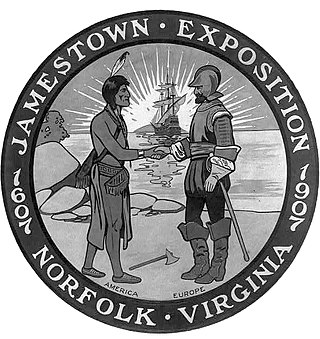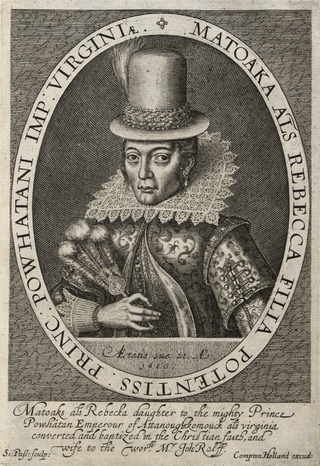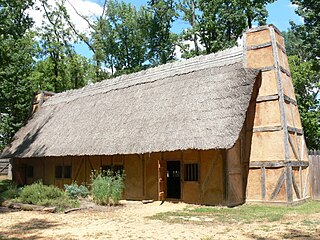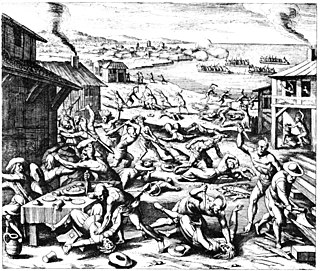Related Research Articles

The Jamestown settlement in the Colony of Virginia was the first permanent English settlement in the Americas. It was located on the northeast bank of the James River, about 2.5 mi (4 km) southwest of the center of modern Williamsburg. It was established by the Virginia Company of London as "James Fort" on May 4, 1607 O.S., and was considered permanent after a brief abandonment in 1610. It followed several failed attempts, including the Lost Colony of Roanoke, established in 1585 on Roanoke Island, later part of North Carolina. Jamestown served as the colonial capital from 1616 until 1699. Despite the dispatch of more settlers and supplies, more than 80 percent of the colonists died in 1609–1610, mostly from starvation and disease. In mid-1610, the survivors abandoned Jamestown, though they returned after meeting a resupply convoy in the James River.

Jamestown Settlement is a living history museum operated by the Commonwealth of Virginia, created in 1957 as Jamestown Festival Park for the 350th anniversary celebration. Today it includes a recreation of the original James Fort, a Powhatan Native American town, indoor and outdoor displays, and replicas of the original settlers' ships: the Susan Constant, Godspeed, and Discovery.

John Smith was an English soldier, explorer, colonial governor, admiral of New England, and author. He played an important role in the establishment of the colony at Jamestown, Virginia, the first permanent English settlement in North America, in the early 17th century. He was a leader of the Virginia Colony between September 1608 and August 1609, and he led an exploration along the rivers of Virginia and the Chesapeake Bay, during which he became the first English explorer to map the Chesapeake Bay area. Later, he explored and mapped the coast of New England. He was knighted for his services to Sigismund Báthory, Prince of Transylvania, and his friend Mózes Székely.

The Jamestown Exposition, also known as the Jamestown Ter-Centennial Exposition of 1907, was one of the many world's fairs and expositions that were popular in the United States in the early part of the 20th century. Commemorating the 300th anniversary of the founding of Jamestown in the Virginia Colony, it was held from April 26 to December 1, 1907, at Sewell's Point on Hampton Roads, in Norfolk, Virginia. It celebrated the first permanent English settlement in the present United States. In 1975, the 20 remaining exposition buildings were included on the National Register of Historic Places as a national historic district.

Ambrose Powell Hill Jr. was a Confederate general who was killed in the American Civil War. He is usually referred to as A. P. Hill to differentiate him from Confederate general Daniel Harvey Hill, who was unrelated.

Pocahontas was a Native American woman belonging to the Powhatan people, notable for her association with the colonial settlement at Jamestown, Virginia. She was the daughter of Powhatan, the paramount chief of a network of tributary tribes in the Tsenacommacah, encompassing the Tidewater region of what is today the U.S. state of Virginia.

John Rolfe was an English explorer, farmer and merchant. He is best known for being the husband of Pocahontas and the first settler in the colony of Virginia to successfully cultivate a tobacco crop for export.
Thomas Rolfe was the only child of Pocahontas and her English husband, John Rolfe. His maternal grandfather was Chief Powhatan, the leader of the Powhatan tribe in Virginia.

Sewells Point is a peninsula of land in the independent city of Norfolk, Virginia in the United States, located at the mouth of the salt-water port of Hampton Roads. Sewells Point is bordered by water on three sides, with Willoughby Bay to the north, Hampton Roads to the west, and the Lafayette River to the south. It is the site of Naval Station Norfolk.

State Route 31 is a primary state highway in the U.S. state of Virginia. The state highway runs 24.56 miles (39.53 km) from U.S. Route 460 in Wakefield north to SR 5 and SR 199 in Williamsburg. SR 31 is the primary north–south highway of Surry County, where the highway serves the towns of Surry and Dendron. The state highway also connects Williamsburg with Jamestown. The sections of SR 31 on either side of the James River are connected by the Jamestown Ferry.

Fitzhugh Lee was a Confederate cavalry general in the American Civil War, the 40th Governor of Virginia, diplomat, and United States Army general in the Spanish–American War. He was the son of Sydney Smith Lee, a captain in the Confederate States Navy, and the nephew of Robert E. Lee.

First Families of Virginia (FFV) are the families in colonial Virginia who are socially prominent and wealthy, but not necessarily the earliest settlers. They descend from English colonists who primarily settled at Jamestown, Williamsburg, the Northern Neck and along the James River and other navigable waters in Virginia during the 17th century. These elite families generally married within their social class for many generations and, as a result, most surnames of First Families date to the colonial period.

The "Citie of Henricus"—also known as Henricopolis, Henrico Town or Henrico—was a settlement in Virginia founded by Sir Thomas Dale in 1611 as an alternative to the swampy and dangerous area around the original English settlement at Jamestown, Virginia. It was named for Henry, Prince of Wales (1594–1612), the eldest son of King James I.

John Pelham was a Confederate cavalry soldier under J. E. B. Stuart during the American Civil War. Robert E. Lee called Pelham "The Gallant Pelham" for his use of light artillery at the Battle of Fredericksburg to delay U.S. soldiers.

Historic Jamestown is the cultural heritage site that was the location of the 1607 James Fort and the later 17th-century town of Jamestown in America. It is located on Jamestown Island, on the James River at Jamestown, Virginia and operated as a partnership between Preservation Virginia and the U.S. National Park Service as part of Colonial National Historical Park.
Parke Shepherd Rouse Jr. was an American journalist, writer and historian in Tidewater Virginia.

The Anglo–Powhatan Wars were three wars fought between settlers of the Colony of Virginia and the Powhatan People of Tsenacommacah in the early 17th century. The first war started in 1609 and ended in a peace settlement in 1614. The second war lasted from 1622 to 1632. The third war lasted from 1644 until 1646 and ended when Opechancanough was captured and killed. That war resulted in a defined boundary between the Indians and colonial lands that could only be crossed for official business with a special pass. This situation lasted until 1677 and the Treaty of Middle Plantation which established Indian reservations following Bacon's Rebellion.

Jamestown, also Jamestowne, was the first settlement of the Virginia Colony, founded in 1607, and served as the capital of Virginia until 1699, when the seat of government was moved to Williamsburg. This article covers the history of the fort and town at Jamestown proper, as well as colony-wide trends resulting from and affecting the town during the time period in which it was the colonial capital of Virginia.
Reverend Richard Buck was a minister to the Colony of Virginia at Jamestown, Virginia from 1610 to 1624. He was chaplain of the first session of the Virginia General Assembly, which was composed of the House of Burgesses and the Virginia Governor's Council. This assembly met in the church at Jamestown on July 30, 1619, as the first elected assembly and law making body in colonial America.

The Virginia Women's Monument is a state memorial in Richmond, Virginia commemorating the contributions of Virginia women to the history of the Commonwealth of Virginia and the United States of America. Located on the grounds of the Virginia State Capitol, the monument is officially titled Voices from the Garden: The Virginia Women's Monument and features life-sized bronze statues of eleven Virginia women placed in a small granite plaza.
References
- Halsey, Don. "A History of the Pokahuntas Bell Moulded for Jamestown Exposition". Culpeper: Culpeper Exponent Power Presses, 1909.
- ↑ "A History of the Pocahontas Bell". National Bell Festival. 2023-07-28. Retrieved 2023-07-31.
- ↑ American Monthly Magazine, by Daughters of the American Revolution, 1905
- ↑ Charleston Gazette, "Woman Historian, Civic Leader, Dies", October 28, 1937
- ↑ Richmond Times-Dispatch, "Pokahuntas Bell for Exposition", April 13, 1907
- ↑ "Every Piece of Metal that Went into Making the Pocahontas Bell". National Bell Festival. 2023-07-29. Retrieved 2023-08-07.
- ↑ Richmond Times Dispatch, "Pokahuntas Bell, May 6, 1907
- 1 2 Richmond Times-Dispatch, "Pokahuntas Bell: Pleasant Presentation at Fort Boon on Exposition Grounds", June 16, 1907
- ↑ Washington Herald, "In Memory of Pocahontas, June 23, 1907